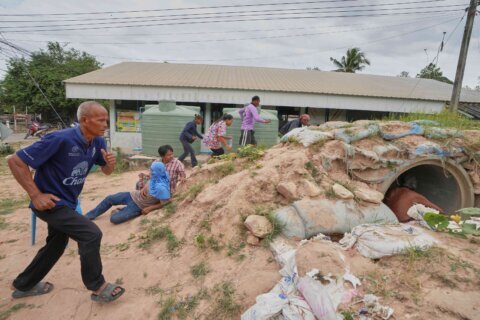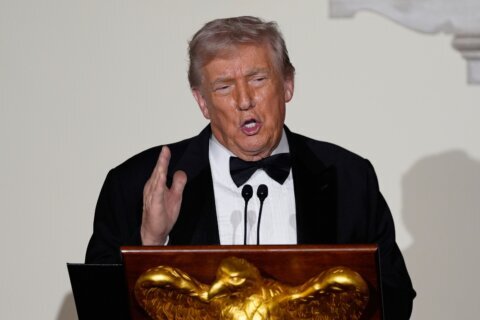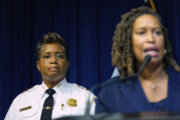WASHINGTON — John and Sarah Weldon sit side-by-side outside the Baltimore Convention Center, smoking cigarettes and watching adults wearing “My Little Pony” costumes flutter around them.
The two drove from Delaware with their other siblings and mother for the third annual Bronycon, the world’s biggest gathering of “My Little Pony” fans.
“I know it’s a kids’ show, but I still really like it,” John Weldon says.
“Our little sister got us into it,” Sarah Weldon says as she absentmindedly strokes her blue, furry ears.
She is outfitted in head-to-toe blue: blue knee-high socks, blue and pink tutu, blue tank top and, of course, blue ears.
“Dash is my favorite character,” the 24-year-old says. “She’s strong, but cool.”
Bronies, adult fans of the animated show about magical ponies that live in a world called Equestria, are relative newcomers to the already robust world of cosplay, or costume play.
They join more familiar diehards such as Trekkies — “Star Trek” fans — in dressing up like their favorite characters and attending conventions that draw legions of the faithful.
But despite the sparkles, rainbows and ponies, the brony world is not easy to infiltrate.
Shunned by mainstreamers and even other cosplayers, bronies tend to keep to themselves and can be distrustful of the uninitiated.
When asked how he thinks the outside world views him, LJ, who asked that his last name not be used, smiles and says, “I don’t go out much.”
Sarah Weldon echoes the sentiment.
“It’s not really an issue. We don’t have a big circle of friends,” she says.
This shyness might explain why repeated calls, emails and even tweets to the organizers of Bronycon went unanswered.
Maria Helena Carey, a D.C.-based photojournalist, spent the better part of a year researching brony culture for her master’s thesis at the Corcoran Gallery of Art. She met dozens of male and female bronies in the D.C. region, and says she felt welcomed by the group after its members started to trust her.
“The public still doesn’t really understand bronies,” she says.
The common misconceptions surrounding brony subculture likely explains why the convention’s organizers were skittish: They get called everything from overgrown adults to child molesters, Carey says.
But “there was a time when people thought Trekkies were total weirdos,” she says.
Carey started her research after discovering the modern version of “My Little Pony: Friendship is Magic,” a reboot of the original 1983 show created by Hasbro Studios.
When Carey was a child, her mom disapproved of the show and felt it was “designed expressly by Hasbro to sell toys to girls.” She refused to buy Carey a pony doll, even though all the cool girls had one — something that irritated Carey, but not enough for her to make a fuss over it.
But in 2008, when Carey was pregnant with her second son, her mom finally gave in and bought her a pony figurine as a joke. Sometime after, Carey’s friend suggested that she watch the new show, which debuted in 2010.
Carey obliged and found that she and her two sons thoroughly enjoyed the series. She noticed very adult references to pop culture, and found the writing to be remarkably smart, and even snarky, for a kids show. In one episode, the characters from “The Big Lebowski” make a cameo. And a scene from “Star Wars: A New Hope” was borrowed for the pilot.
Carey’s little boys also found something they liked in the friendships among the ponies, named Twilight Sparkle, Applejack, Rarity, Fluttershy, Rainbow Dash and Pinkie Pie.
“The whole family fell in love,” she says. “There’s smart writing, it’s funny and it has great songs.”
But if her interest in “My Little Pony” is considered strange for an adult, the fact that her sons watch the show was deemed positively unsavory by some families at their Capitol Hill school.
Before she knew it, Carey’s family was embroiled in a gender studies battle.
“It brought up the whole thing about what is a show for boys and what is a show for girls,” she says.
Despite the social stigma against bronies, Carey was surprised to find a large local contingent of “My Little Pony” enthusiasts. At her first meet-up, Carey met roughly 120 bronies from D.C., Maryland and Virginia.
“They’re getting so big that D.C. [bars] are having a hard time accommodating them,” she says, adding that the group now holds some of its bigger gatherings in Arlington, where the bars are bigger.
When she first walked in, Carey wasn’t sure what to expect from this strange group of people wearing pony paraphernalia. Eventually they warmed up to her; some even invited her into their tight-knit group.
“I think bronies are a little shyer and a little more self-perceived as being socially awkward,” she says. “But in general many of them are very artistic and loved drawing and cosplay. One girl works for the IRS, and other at Geico. Some are lawyers and engineers. They’re just people from varied walks of life.”
Back at the convention, John and Sarah Weldon exchange fan swag with some friends they met in the lobby. They take pictures, flip through comic books and tell stories of hearing their favorite character speak during the panels.
When asked what she thinks about her first Bronycon, Sarah Weldon points to her family and shrugs.
“I can be myself here,” she says.
Meet some real-life bronies in the video below:
I am a Brony (v2) from Maria Helena Carey on Vimeo.
Follow @WTOP and WTOP Entertainment on Twitter and WTOP on Facebook.







